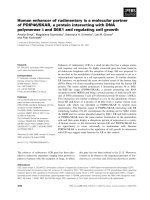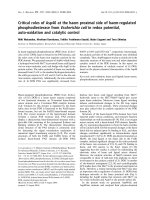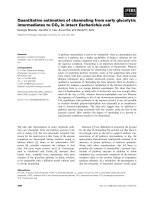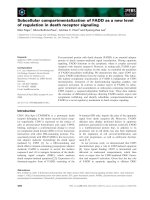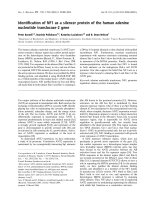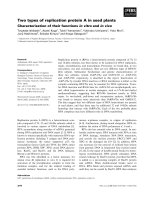báo cáo khoa học: "Conditional probabilities of identity of genes at a locus linked to a marker" potx
Bạn đang xem bản rút gọn của tài liệu. Xem và tải ngay bản đầy đủ của tài liệu tại đây (598.96 KB, 13 trang )
Conditional
probabilities
of
identity
of
genes
at
a
locus
linked
to
a
marker
C. CHEVALET
M.
GILLOIS
Jacqueline
VU
TIEN
KHANG*
LN.R.A.,
Laboratoire
de
Genetique
cellulaire,
*
Station
d’Amélioration
genetique
des
Animaux,
Centre
de
Recherches
de
Toulouse,
B.P.
12,
F
31320
Castanet-Tolosan
Summary
A
method
is
given
for
determining
the
probabilities
that
genes
are
identical
by
descent,
at
a
locus
linked
to
a
marker
where
phenotypic
data
are
available.
For
tight
linkage,
such
conditional
probabilities
of
identity
may
differ
very
much
from
unconditional
ones ;
they
depend
on
the
dominance
relationships
between
alleles
at
the
marker
locus,
and
on
the
allelic
frequencies.
Appli-
cations
discussed
refer
to
the
calculation
of
general
two-locus
descent
measures,
to
the
validation
of
pedigrees
from
polymorphism
analysis,
and
to
the
statistical
detection
of
an
association
between
a
quantitative
trait
and
a
marked
region
of
the
genome.
Key
words :
Identity
by
descent
of
genes ;
recombination ;
genetic
polymorphism.
Résumé
Probabilités
conditionnées
d’identité
entre
gènes
en
un
locus
lié
à
un
marqueur
On
donne
une
méthode
pour
calculer
les
probabilités
d’identité
entre
des
gènes
d’un
locus,
conditionnées
par
l’observation
des
phénotypes
en
un
locus
marqueur
lié.
La
méthode
proposée
réunit
2
approches :
les
probabilités
d’identité
conditionnelles,
au
locus
marqueur,
sont
calculées
en
construisant
les
événements
possibles
du
processus
de
la
ségrégation
des
gènes ;
les
probabilités
conditionnelles
d’identité
en
un
locus
voisin
sont
calculées
ensuite
par
la
méthode
des
arbres
géniques,
modifiée
pour
tenir
compte
des
conditions
réalisées
au
locus
marqueur.
Les
résultats
dépendent
des
relations
de
dominance
entre
allèles
et
des
fréquences
alléliques
au
locus
marqueur ;
pour
une
liaison
étroite,
ils
peuvent
être
très
différents
des
résultats
non
conditionnés.
Les
appli-
cations
discutées
concernent
une
méthode
générale
de
calcul
des
coefficients
d’identité
à
2
locus,
l’étude
de
la
cohérence
entre
des
données
généalogiques
et
un
polymorphisme
génétique,
et
les
méthodes
de
détection
statistique
d’une
association
entre
un
caractère
quantitatif
et
une
région
marquée
du
génôme.
Mots
clés :
Identité
entre
gènes ;
recombinaison ;
polymorphisme
génétique.
I.
Introduction
Several
methods
of
computing
probabilities
that
genes
at
a
single
locus
are
identical
by
descent
have
been
published
(G
ILLOIS
,
1964,
1966 ;
C
HEVALET
,
1971 ;
C
OCKERHAM
,
1971 ;
N
ADOT
&
V
AYSSEX
,
1973 ;
D
ENNISTON
,
1974 ;
C
HEVALET
et
Cl
l.,
1977 ;
Vu
T
IEN
K
HAN
G
et
C
ll.,
1979).
Except
for
the
works
by
WEIR
&
COCKER
HAM
(1969a),
COCKER
H
AM
&
WEIR
(1973)
and
D
ENNI
S
TON
(1975),
papers
dealing
with
2
linked
loci
have
been
mostly
concerned
with
the
change
in
time
of
mean
descent
measures
in
populations
with
fixed
mating
rules
(CO
CKERHAM
&
WEIR,
1968,
1973 ;
CI
ALLAIS
,
1970 ;
WEIR
&
C
OCKERHAM
,
1969b,
1973,
1974).
In
this
paper,
we
consider
the
case
where
some
phenotypic
information
is
available
at
a
marker
locus
linked
to
the
locus
at
which
probabilities
are
to
be
computed.
We
give
a
solution
to
this
problem
which
has
not
been
previously
studied
in
a
general
way,
and
we
specify
some
rules
that
allow :
(1)
computation
of
probabilities
of
identity
of
genes
at
a
marker
locus,
conditional
on
the
observation
of
phenotypes
among
relatives,
and
(2)
derivation
of
probabilities
of
identity
at
a
locus
linked
to
such
a
marker.
Methods
used
here
combine
the
approaches
developed
by
C
HEVALET
(1971),
on
the
one
hand,
and
by
G
ILLOIS
(1964)
and
Vu
T
IEN
K
HANG
et
al.
(1979),
on
the
other
hand.
Applications
outlined
in
the
discussion
are :
general
calculation
of
two-locus
descent
measures
from
pedigree
data,
validation
of
pedigrees
from
polymorphism
analysis,
and
detection
of
associations
between
a
marker
locus
and
linked
genes
contributing
to
a
quantitative
character.
II.
Conditional
probabilities
of
identity
of
genes
at
a
marker
locus
We
consider
a
diploid
population
and
a
marker
locus.
We
assume
that
the
system
is
autosomal,
regular
and
thoroughly
described :
any
genotype
gives
rise
to
a
unique
phenotype,
and
dominance
relationships
between
alleles
and
allelic
frequencies
are
known.
We
first
recall
the
expression
for
the
a
priori
probability
of
the
observed
phenotypes,
given
the
pedigree
[formulae
(1),
(2)] ;
then
we
show
how
to
derive
the
conditional
probabilities
of
identity
at
the
marker
locus
given
the
observed
phenotypes
[formulae
(3),
(4)].
As
an
example,
we
use
the
pedigree
made
up
of
one
mother
and
her
2
offspring
born
of 2
unrelated
fathers
(fig.
1),
and
the
human
ABO
blood
group
system
as
a
marker.
In
a
pedigree,
let
N
be
the
number
of
parent-offspring
links.
Two
mutually
exclusive
and
equiprobable
segregational
events
may
correspond
to
each
link,
at
any
locus,
which
will
be
called
elementary
events.
A
gene
transmitted
to
some
offspring
by
1
zygote
originates
from,
and
is
therefore
identical
to,
1
of
the
2
homologous
genes
carried
by
this
zygote.
So,
a
pedigree
with
N
links
gives
rise
to
2N
possible
events
(fig.
1),
each
of
which
is
made
up
of
N
elementary
events. Let
w
denote
any one
of
these
mutually
exclusive
events.
In
any one
of
them,
every
gene
in
the
population
is
given
the
name
of
the
founder
gene
from
which
it
derives ;
genes
bearing
the
same
name
in
some
event
w
are
identical
by
descent,
and
if
genes
in
a
fixed
set
of
genes
are
isonymous
in
M
events,
out
of
the
2N
possible
ones,
their
probability
of
being
identical
by
descent
is :
M.2-
N.
Monte
Carlo
simulations
of
the
segregational
process
make
this
approach
feasible
for
large
pedigrees ,and
small
subsets
of
genes
(C
HEVALET
,
1971).
rm.
1
The
22
exclusive
events
associated
with
the
pedigree
made
up
of
7
mother
m
and
her
2
offspring
o,
and
02
born
of
2
unrelated
fathers.
Les
22
événements
exclusifs
asssociés
au
pedigree
constitué
d’une
mere
m et
de
ses
2
enfants
o,
et
02
nés de
2
pères
non
apparentes.
Genes
carried
by
the
mother
are
named
x
and
y.
Les
genes
portes
par
la
mère
sont
designes
par
x et
y.
For
any
event
w,
genes
belonging
to
zygotes
of
known
phenotypes
are
found
in
some
1
identity
situation.
Conditional
on
w,
the
probability
of
any
list
G
of
genotypes,
for
these
zygotes,
reads :
where :
PU
is
the
frequency
of
the
u-th
allele
A.
at
the
marker
locus ;
nu
(G,w)
is
the
number
of
distinct
founder
genes
that
should
be
associated
with
allele
Au,
so
as
to
realize
the
list
G
under
the
condition
w ;
8
(G,w)
is
either
1,
if
G
is
allowed
by
w,
or
0
if
it
is
not
(for
instance,
a
zygote
cannot
be
heterozygous
in
a
situation
where
its
2
genes
are
identical).
It
should
be
stressed
here
that
in
the
specification
of
events
w,
homologous
genes
of
paternal
and
maternal
origin,
within
a
zygote,
do
not
play
symmetrical
roles.
It
follows
that
any
heterozygotic
phenotype
[A
.
Al
must
be
split
into
the
2
possible
ordered
genotypes
(A
uAv)
and
(A!A&dquo;).
With
the
convention
that
the
gene
of
paternal
origin
is
cited
first,
and
following
the
notation
in
figure
1,
we
get,
for
example :
With
dominance
interactions
between
alleles,
any
list
P
of
phenotypes
may
be
realized
by
a
series
of
genotypic
lists
G,,.
Extension
of
formula
(1)
gives :
If
this
probability
is
not
zero
for
at
least
some
one
w
event,
application
of
Bayes’rule
yields :
,!
Now,
we
are
generally
interested
in
the
identity
situations
occurring
among
genes
of
a
small
subset.
Let
Q
be
such
a
situation,
and
A
(S2,w)
the
function
equal
to
1
if
Q
is
implied
by
00
,
and
to
0
if
not.
We
get :
where
terms
Pr
(w/P)
are
given
by
formula
(3).
As
an
example,
we
take
as
Q
the
situation
where
genes
of
offspring
originating
from
the
mother
are
identical
(fig.
1).
The
unconditional
probability
of
Q
is
1/2 ;
applications
of
formula
(4)
give :
The
last
example
shows
that
some
phenotypic
data
may
be
important
although
they
refer
to
zygotes
which
do
not
carry
any
gene
that
can
give
rise
to
some
gene
found
in
the
Q
situation.
Hence
no
simple
rule
could
be
stated,
that
permitted
eliminating
useless
information.
As
in
the
case
of
unconditional
probabilities,
an
approximate
calculus
may
be
proposed,
based
on
Monte
Carlo
simulations.
Many
independent
events
w<
(f
=
1, 2,
,
L)
are
generated.
For
each
one,
the
conditional
probability,
Pr
(P/w(),
is
derived
by
formula
(2).
Then
exact
formula
(4)
is
replaced
by
an
estimated
value :
provided
that
the
denominator
is
not
zero.
However,
the
estimation
is
generally
biased.
The
bias
decreases
as
L
increases,
but
increases
with
the
unknown
frequency
of
forbidden
w
events.
Computer
programs,
written
in
the
Fortran
77
language
and
following
algorithms
derived
from
formulae
(4)
and
(5),
are
available
by
contacting
the
authors.
III.
Conditional
probabilities
of
identity
of
genes
at
a
locus
linked
to
the
marker
At
a
locus,
linked
to
the
marker
with
a
non-zero
probability
of
recombination,
À,
and
where
no
phenotypic
information
is
available,
every
segregational
event
allowed
by
the
pedigree
is
possible,
but
the
probabilities
attached
to
the
2N
events
are
not
equal.
Consider,
at
the
marker
locus,
one
of
the
possible
events,
00
,
with
its
conditional
probability
Pr
(w/P)
(formula
(3)).
Let
w’
be
1
event
at
the
2nd
locus.
For
every one
of
the
N
parent-offspring
links,
w
and
w’
indicate
from
which
parental
chromosomes
both
offspring
genes
derive :
w
and
w’
state
either
that
both
genes
originate
from
the
same
chromosome
in
the
parent
(fig.
2,
case
1),
or
that
they
derive
from
the
2
homo-
logous
chromosomes
in
the
parent
(case
2).
In
the
1st
case,
there
is
no
recombination,
and
the
elementary
event
attached
to
that
link
in
w’
has
probability
(1 —
7,,),
conditional
on
the
elementary
event
attached
to
that
same
link
in
m ;
in
the
2nd
case
a
recombination
is
involved
for
that
link,
and
the
conditional
probability
is
X.
Denoting
by
p
(w,
w’)
the
number
of
links
of
the
1st
kind,
we
have :
and
further :
This
formula
(6)
is
the
counterpart
of
formula
(3),
for
a
locus
linked
to
the
marker.
Calculations
may
be
made
simpler,
using
the
method
of
genic
trees
(Vu
T
IEN
KH
wNG et
al.,
1979).
In
this
algebraic
approach,
the
set
of
genes
at
some
one
locus
is
identified
with
the
set
made
up
of
the
N
parent-offspring
links
(a,
b)
in
the
pedigree.
So,
the
gene
carried
by
some
zygote
(b)
and
originating
in
its
parent
(a)
is
denoted
by
the
pair
(a,
b)
(fig.
3a,
3b).
A
relation
of
ancestry
between
genes
is
derived
from
that
described
in
the
zygotic
network,
in
such
a
way
that
both
genes
(a’,
a)
and
(a&dquo;,
a)
carried
by
zygote
(a)
are
said
to
be
the
«
1-ancestors
»
of
the
(a,
b)
gene
transmitted
by
(a)
to
any
offspring
(b).
So,
the
set
of
genes
is
given
a
structure
of
partially
ordered
set,
in
which
any
segregation
event
w
can
be
represented
in
the
following
way.
The
2
mutually
exclusive
elementary
events
attached
to
1
link
between
parent
(a)
and
offspring
(b)
are described
in
the
genic
set
by
the
2
gametic
links
((a’,
a), (a,
b))
and
((a&dquo;,
a),
(a,
b)).
According
to
anyevent
w,
every
gene
(a,
b)
is
then
linked
upwards
to
only
1
gene
among
its
2
«
1-ancestors
»,
and
downwards
to
0,
one
or
several
genes
(b,
c)
carried
by
the
offspring
(c)
of
(b).
(a)
The
zygotic
network
and
the
phenotypic
data ;
Le
reseau
zygotique
et
les
données
phénotypiques ;
(b)
The
associated
gametic
network ;
Le
réseau
gúmétique
associé ;
(c)
List
of
identity
situations
between
the
3
genes
(b,
c),
(b,
d)
and
(a,
d) ;
Liste
des
situations
d’identite
entre
les
3
gènes
(b,
c),
(b,
d)
et
(a,
d) ;
(d)
Admissible
segregation
events
at
the
marker
locus.
Evénéments
possibles
au
locus
marqueur.
Therefore
in
any
w,
the subset
made
up
of
all
the
genes
which
are
identical
to
one
founder
gene
has
the
structure
of
a
tree,
the
root
of
which
is
the
founder
gene,
and
the
whole
set
of
genes
is
split
into
disjoint
subsets
which
are
trees
in
the
ordered
set
of
genes
(fig.
3d).
The
basic
rule
is
then
as
follows.
One
considers
situations
Id
(9’)
according
to
which
all
genes
in
a
subset 9’
are
identical.
This
situation
arises
for
segregation
events
in
which
the
genes
involved
pertain
to
a
tree,
in
the
ordered
set
of
genes.
To
any
situation
Id
(9’),
corresponds
a
family
(.71¡,
m;
;
i
=
1,
,
I)
of
trees
.!;,
where
mi
is
the
number
of
genes
in
.71¡.
The
unconditional
probability
of Id
(9’)
is
then
written :
The
pedigree
and
the
phenotypic
data
are
those
of
figure
3a.
Le
pedigree
et
les
données
phenotypigues
sont
ceux
de
la
figure
3a.
(a)
Gametic
trees
corresponding
to
identity
within
subsets
of
genes ;
Arbres
gamétiques
correspondant
a
l’identité
de
sous-ensembles
de
genes ;
(b)
Values
of the
numbers
p
(w,
s9),
cf.
formula
(7).
Valeurs
des
nombres
p
(w,
s1),
cf.
formule
(7).
Considering
the
situation
Id,
(!)
at
the
2nd
locus
linked
to
the
marker,
any
tree
si
i
may
still
be
realized,
and
is
the
union
of
w’
events
whose
probabilities,
conditional
on
some
w
at
the
1st
locus,
are
given
by
(6).
Except
for
the
root,
any one
of
the
genes
in
.!4;
has
its
origin
specified
among
its
2
«
1-ancestors
» ;
the
specification
is
either
identical
to
(fig.
2,
case
1),
or
different
from
(case
2),
that
given
in
the
w
event.
Letting
p
(w,
sl
i)
be
the
number
of
coincidences
between
w
and
s4i,
we
then
have :
and,
conditional
on
a
phenotypic
list
PI
at
the
1st
marker
locus :
Extensions
to
identity
situations
involving
2
or
more
independent
groups
of
identical
genes
follow
the
corresponding
analysis
by
genie
trees,
for
one-locus
situations
(Vu
T
IEN
K
HANG
et
al.,
1979).
An
example
is
presented
in
figures
3
and
4,
with
the
results
given
in
appendix.
IV.
Discussion
In
the
1st
instance,
it
seems
worth
citing
some
technical
by-products
of
the
previous
analysis.
The
rules
combining
segregational
events
at
2
linked
loci
(formulae
(6),
(7))
have
a
direct
application
to
the
computation
of
two-locus
descent
measures
in
the
general
case,
when
no
phenotypic
information
is
available.
Consider
2
subsets, !
and
J,
in
the
set
of
genes
denoted
by
parent-offspring
links,
and
the
situation :
Q =
(ld,
(!),
Id
2
(’2J»
stating
that
gene
of Y
at
locus
1
are
identical,
and
that
genes
of
J
at
locus
2
are
identical.
Identity
of 9
genes
is
made
possible
by
a
set
of
I
trees
sii,
with
mi
genes
in
A
i (i
=
1,
,
I)
(resp. :
J
trees
36
,,
n,, j
=
1, 2 ,
J
for
’2J).
Any
pair
of
trees
(iii,
!!)
makes
the
situation
Q
possible.
Assuming
that
Id,
(9’)
is
realized
by
the
tree
A;,
we
have
to
compute
the
probability
of
ld
2
(’2J)
through
the
tree
S!j
and
conditional
on
.!?;
at
the
1st
locus.
Relative
to
A;
,
any
gametic
link
((a,
b),
(b, c))
in
9S
j
may
be
of
3
kinds :
(1)
gametic
link
((a,
b),
(b,
c))
is
found
in
sdi,
then
we
are
in
case
1
of
figure
2,
the
conditional
probability
of
the
elementary
event
is
(1 —
X).
(2)
gametic
link
((a,
b),
(b,
c))
is
not
in
!,,
but
the
gametic
link
((a’,
b),
(b,
c))
is
in
sA
;
:
according
to
the
events
93i
the
gene
(b,
c)
transmitted
by
zygote
(b)
to
zygote
(c)
originates
in
the
parent
(a)
of
(b),
while
in
the
events
A;,
the
gene
(b,
c)
originates
in
the
other
parent
(a’)
of
(b) ;
this
situation
implies
a
recombination
event
during
meiosis
in
zygote
(b),
we
are
in
case
2,
the
conditional
probability
is
!
(3)
neither
((a,
b),
(b,
c))
nor
((a’,
b),
(b, c))
is
found
in
!;,
then
the
segregation
event
described
in
this
gametic
link
of
Sij
is
independent
of
those
specified
by
,!A;,
the
probability
attached
to
the
elementary
event
is
2.
Let
p;!
and
q;!
be
the
numbers
of
(J
1Bj
gametic
links
of
the
1st
and
the
2nd
kinds,
respectively.
We
get :
Extensions
to
situations
involving
several
groups
of
identical
genes
at
both
loci
follow
the
same
rationale.
This
analysis
provides
a
generalization
of
that
given
by
D
ENNISTON
(1975),
since
it
is
not
restricted
to
situations
found
between
genes
taken
from
«
regular
(non-inbred)
relatives.
We
may
stress
that
working
within
a
set
of
genes
(the
set
of
parent-offspring
links
considered
as
genes,
chromosomes
or
gametes)
makes
the
analysis
general
and
simpler :
it
does
not
exclude
inbreeding,
and
only
2
basic
meiotic
events
(fig.
2)
need
be
considered,
instead
of
5
when
working
directly
with
«
regular
»
relatives
(D
ENNISTON
,
1975,
fig.
4).
The
calculations
done
to
get
the
conditional
probabilities
of
identity
at
a
marker
locus
involve
verifying
whether
genealogical
and
phenotypic
data
are
compatible.
As
such,
the
method
may
provide
an
extension
of
those
used
to
validate
genealogies
in
domestic
animals,
or
to
test
paternity
in
humans
from
analysis
in
trios
or
in
sibships
(C
HASTANG
,
1976).
For
that,
we
have
only
to
decide
whether
lists
G.
of
genotypes
are
admissible
or
not ;
the
complete
list
of
alleles
and
their
dominance
relations
should
be
sufficient,
and
the
calculations
of
allelic
frequencies
products
useless
(formulae
(1)
and
(2)).
The
method
might
improve
the
efficiency
of
classical
ones
in
complex
situations
with
dominance
between
alleles,
or
with
incomplete
phenotypic
information
(fig.
5).
The
genetic
system
is
the
A,A
z
BO
human
blood
group
system
(A,
dominant
over
A2
and
0,
A2
dominant
over
0,
and
B
dominant
over
0).
Every
trio
(mother-father-offspring)
is
admissible ;
the
left
and
right
parts
of the
pedigree
are
admissible
subsets ;
the
whole
set
becomes
admissible
if
the
phenotype
of
any
of
a,
b,
c,
d,
e,
i, j
or
k
is
unknown.
Le
marqueur
est
le
système
sanguin
humain
AA
2
BO
(A
r
est
dominant
sur
Az
et
sur
O ;
A2
et
B
sont
dominants
sur
O).
Chacrrn
des
trios
(m£re-p£re-enfant)
est
admissible ;
les
parties
gauche
et
droite
du
pedigree
constituent
des
sous-ensembles
admissibles ;
l’ensemble
de
la
généalogie
devient
admissible
si
le
phénotype
de
a,
b,
c,
d,
e,
i, j
ou
k
est
inconnu.
The
main
results
of
this
work,
as
expressed
in
formulae
(3),
(4)
and
(7),
provide
a
solution
to
a
problem
which
had
no
solution,
except
in
the
special
circumstance
ot
a
locus
linked
to
a
locus
forced
to
remain
heterozygous
(H
ANSET
,
1974,
and
references
therein).
Such
studies
are
based
on
the
generation
matrix
method,
which
is
tractable
only
when
dealing
with
very
small
populations
and
fixed
mating
rules,
such
as
sib
mating.
On
the
contrary,
our
method
can
handle
any
pedigree
and
a
large
class
of
genetic
markers,
although
its
use
should
be
restricted
to
rather
sparse
genealogical
networks
or
to
few
generations,
so
as
to
avoid
some
kind
of
«
combinatorial
explosion » ;
;
this
practical
restriction
is
mainly
due
to
the
fact
that,
for
example,
the
conditional
inbreeding
coefficient
of
some
zygote
may
depend
on
the
phenotypes
of
unrelated
individuals,
a
situation
that
forbids
most
simplifications
available
in
the
calculation
of
unconditioned
probabilities.
An
interesting
feature
of
the
conditional
probabilities
is
their
dependence
upon
allelic
frequencies.
This
dependence
may
turn
out
to
be
very
important :
the
probability
of
identity
of
genes
in
zygotes
(c)
and
(d)
(fig.
3),
is
highly
increased
if
alleles
B
and
0
are
rare,
even
for
loose
linkage
(appendix(e)).
This
shows
how
the
description
of
polymorphisms
in
a
population
may
change
the
genetical interpretation
of
correlations
between
traits
measured
in
related
individuals,
if
the
genes
contributing
to
these
traits
are
linked
to
the
markers.
This
evidence
motivated
the
present
work,
and
should
lead
to
its
main
field
of
application.
Methods
to
correlate
genetic
polymorphism
and
variation
in
quantitative
traits
have
been
developed,
using
the
segregation
of
a
marker
gene
among
full
sibs
or
half
sibs
(NE1MAN-S15RENSEN
&
ROBERTSON,
1961 ;
JAYAKAR,
1970 ;
HASEMAN
&
ELSTON,
1972 ;
§
S
OLLER
&
G
ENIZI
,
1978).
Developments
in
gene
mapping
(O
LLIVIER
&
S
ELLIER
,
1982 ;
P
EARSON
et
al.,
1982)
and
evidence
that
a
great
body
of
polymorphic
loci
should
be
identified
by
means
of
molecular
biology
techniques
(SOUTHERN,
1975 ;
W
YMAN
&
WHITE,
1980 ;
S
KOLNICK
&
WHITE,
1982)
are
promising
for
the
genetic
improvement
of
domestic
animals.
Statistical
methods
of
detection
are
based
on
an
analysis
of
variance
aimed
at
pointing
out
the
significance
of
effects
attached
to
the
identity
states
of
genes
linked
to
the
marker
locus.
In
the
case
of
a
population
of
half
sibs
from
an
heterozygous
father,
the
statistical
setting
is
evident
(S
OLLER
&
G
ENEZI
,
1978),
but
it
becomes
intricate
in
the
case
of
a
hierarchical
scheme
(s
sires,
d
dams
per
sire,
n
offspring
per
dam).
Results
of
this
paper
provide
a
way
to
the
automatic
statement
of
the
needed
statistical
model.
For
n
zygotes,
any
identity
situation
may
be
represented
by
an
(n
x
r)
matrix
X,
of
which
element
X,
j
is
the
number
of
genes
from
j-th
origin
carried
by
the
i-th
zygote :
X
ij
is
equal
to
0,
1,
or
2,
row
sums
are
equal
to
2,
and
XX’
is
4
times
the
matrix
of
conditional
coefficients
of
kinship.
Given
the
set
of
identity
situations
represented
by
Xk,
with
their
conditional
probabilities
qk,
the
matrix
of
conditional
coefficients
of
kinship
for
the
marked
region
of
the
genome
is :
The
problem
of
detecting
whether
the
marked
region
contributes
to
the
variability
of
a
trait
Y
is
amenable
to
a
mixed
model
analysis
of
variance,
with
1st
and
2nd
moments
given
by :
where :
Yo
is
a
vector
of
unknown
fixed
effects,
and
Xo
a
known
incidence
matrix ;
oz !
is
the
variance-covariance
matrix
of
observations,
assuming
no
contribution
of
the
marked
region, I
being
taken
as
known ;
02
is
the contribution
of
the
marked
region
to
the
genetic
additive
variance,
and
<)),
;
is
given
by
(9).
The
hypothesis
to
be
tested
is
(ai
=
0),
against
(ozl !
0).
The
general
way
to
compute
the
matrix
<Pc
should
make
it
possible
to
compare
various
mating
schemes,
in
order
to
optimize
the
power
of
the
test
within
fixed
experimental
limits.
Conversely,
observation
of
the
segregations
at
marked
loci
may
be used
as
a
tool
to
improve
selection,
provided
that
a
quantitative
linkage
has
been
proven
between
the
markers
and
the
traits
selected
for.
SO
LLER
&
B
ECKMAN
(1982)
have
stressed
that
it
should
be
quite
efficient
for
within
family
selection
and
preliminary
results
indicate
that
a
typical
situation
in
which
marker-assisted
selection
might
prove
most
useful
is
combined
selection
for
a
trait
with
low
heritability.
Acknowledgments
The
authors
are
indebted
to
J M.
E
LSEN
(Station
d’Amélioration
génétique
des
Animaux,
I.N.R.A.,
Toulouse)
for
his
valuable
suggestions
on
the
manuscript.
Received
August
11,
1983.
Accepted
March
1,
1984.
References
C
HASTANG
C.,
1976.
«
PATER » :
a
program
for
parenthood
diagnosis.
Computer
Programs
in
Biomedicine,
5,
251-258.
C
HEVALET
C.,
1971.
Calcul
automatique
des
coefficients
d’identité.
Ann.
Genet.
Sel.
Anim.,
3,
449-462.
C
HEVALET
C.,
G
ILLOIS
M.,
N
ASSAR
R.,
1977.
Identity
coefficients
in
finite
populations.
I.
Evolution
of
identity
coefficients
in
a
random
mating
dioecious
population.
Genetics,
86,
697-713.
C
OCKERHAM
C.C.,
1971.
Higher
order
probability
functions
of
identity
of
alleles
by
descent.
Genetics,
69,
235-246.
C
OCKERHAM
C.C.,
WEIR
B.S.,
1968.
Sib
mating
with
two
linked
loci.
Genetics,
60,
629-640.
C
OCKERHAM
C.C.,
WEIR
B.S.,
1973.
Descent
measures
for
two
loci
with
some
applications.
Theor.
Popul.
Biol.,
4,
300-330.
D
ENNISTON
C.,
1974.
An
extension
of
the
probability
approach
to
genetic
relationships :
one
locus.
Theor.
Popul.
Biol.,
6,
58-75.
D
ENNISTON
C.,
1975.
Probability
and
genetic
relationships :
two
loci.
Ann.
Hum.
Genet.,
39, 89-104.
G
ALLAIS
A.,
1970.
Covariances
entre
apparentés
quelconques
avec
linkage
et
épistasie.
II.
Evolution
en
regime
d’autofécondation.
Ann.
Génét.
Sel.
Anim.,
2,
417-427.
G
ILLOIS
M.,
1964.
La
relation
d’identite
en
génétique.
These,
Faculté
des
Sciences,
Paris,
294
p.
G
ILLOIS
M.,
1966.
Le
concept
d’identité
et
son
importance
en
génétique.
Ann.
Genet.,
9,
58-65.
H
ANSET
R.,
1974.
Consanguinite
par
croisement
fr6re
x
saeur,
avec
hétérozygotie
forcée
et
viabilités
différentes.
Ann.
Génét.
Sél.
Anim.,
6,
345-368.
H
ASEMAN
J.K.,
E
LST
ON
R.C.,
1972.
The
investigation
of
linkage
between
a
quantitative
trait
and
a
marker
locus.
Behav.
Genet.,
2,
3-19.
J
AYAKAR
S.D.,
1970.
On
the
detection
and
estimation
of
linkage
between
a
locus
influencing
a
quantitative
character
and
a
marker
locus.
Biometrics,
26,
451-466.
N
ADOT
R.,
V
AYSSEI
x
G.,
1973.
Apparentement
et
identite.
Algorithme
du
calcul
des
coefficients
d’identité.
Biometrics,
29,
347-359.
N
EIMANN
-StS
RENSEN
A.,
R
OBERTSON
A.,
1961.
The
association
between
blood
groups
and
several
production
characteristics
in
three
Danish
cattle
breeds.
Acta
Agric.
Scand.,
11,
163-196.
O
LLIVIER
L.,
S
ELLIER
P.,
1982.
Pig
genetics :
a
review. Ann.
Genet.
Sel.
Anim.,
14,
481-544.
P
EARSON
P.L.,
R
ODERI
CK
T.M.,
D
AVISSON
M.T.,
L
ALLEY
P.A.,
O’B
RIEN
S.J.,
1982.
Report
of
the
committee
on
comparative
mapping.
Cytogenet.
Cell.
Genet.,
32,
208-220.
S
KOLNICK
M.H.,
WHITE
R.,
1982.
Strategies
for
detecting
and
characterizing
restriction
fragment
length
polymorphims
(RFLP’s).
Cytogenet.
Cell
Genet.,
32,
58-67.
S
OLLER
M.,
B
ECKMANN
J.S.,
1982.
Restriction
fragment
length
polymorphisms
and
genetic
impro-
vement.
2nd
World
Congress
on
Genetics
applied
to
Livestock
Production,
Madrid,
Octo-
ber
4-8,
1982,
Editorial
Garsi,
Madrid,
7,
396-404.
S
OLLER
M.,
G
ENI
zi
A.,
1978.
The
efficiency
of
experimental
designs
for
the detection
of
linkage
between
a
marker
locus
and
a
locus
affecting
a
quantitative
trait
in
segregating
populations.
Biometrics,
34,
47-55.
SOUTHERN
E.M.,
1975.
Detection
of
specific
sequences
among
DNA
fragments
separated
by
gel
electrophoresis.
J.
Mol.
Biol.,
98,
503-517.
Vu
T
IEN
K
HANG
J.,
de
R
OCHAMBEAU
H.,
C
HEVALET
C.,
G
ILLOIS
M.,
1979.
Analyse
des
pedigrees
et
calcul
des
coefficients
d’identité
par
les
arbres
géniques.
Biom.
J.,
21, 367-387.
WEIR
B.S.,
C
OCKERHAM
C.C.,
1969a.
Pedigree
mating
with
two
linked
loci.
Genetics,
61, 923-940.
WEIR
B.S.,
C
OCKERHAM
C.C.,
1969b.
Group
inbreeding
with
two
linked
loci.
Genetics,
63, 711-742.
WEIR
B.S.,
C
OCKERHAM
C.C.,
1973.
Mixed
self
and
random
mating
at
two
loci.
Genet.
Res.
Camb.,
21, 247-262.
WEIR
B.S.,
C
OCKERHAM
C.C.,
1974.
Behavior
of
pairs
of
loci
in
finite
monoecious
populations.
Theor.
Popul.
Biol.,
6,
323-354.
W
YMAN
A.R.,
WHITE
R.,
1980.
A
highly
polymorphic
locus
in
human
DNA.
Proc.
Natl.
Acad.
Sci.
U.S.A.,
77,
6754-6758.
Appendix
Results of
the
calculations
associated
with
the
example
of
figures
3
and
4.
Résultats
des
calculs
associés
a
1’exemple
des
figures
3 et
4.
(a)
Unconditional
probabilities
of
identity
situations
(cf.
figure
3c).
Probabilités
non
conditionnelles
des
situations
d’identit
g.
(b)
Conditional
probabilities
of
admissible
events
at
the
marker
locus
(cf.
formula
(3)
and
fig.
3d) :
Probabilités conditionnelles
des
événements
admissibles
au
locus
marqueur.
(c)
Conditional
probabilities
of
identity
situations
at
the
marker
locus.
Probabilités
conditionnelles
des
situations
d’identit
g
au
locus
marqueur.
(d)
Conditional
probabilities
of
identity
situations
at
a
locus
linked
to
the
marker
with
a
recombination
fraction
X,
(p
=
1 —
À) :
Probabilit
gs
conditionnelles
des
situations
d’identite
i
un
locus
li
g
au
marqueur
avec
une
fréquence
de
recombinaison
!.,
(p
=
1 —
X) :
(e)
Conditional
values
of
the
inbreeding
coefficient
f,
of
(d),
and
of
the
kinship
coef-
ficient
4),
d
between
(c)
and
(d)
as
functions
of
X,
for
frequencies
p,
of
allele
A
equal
to
.30
and
.90
(
PA
=
1 -
PO
-
PB)’
Valeurs
conditionn
g
es
du
coefficient
de
consanguinit
g
fd
de
(d)
et
du
coefficient
de
parente
<
P
oo
entre
(c)
et
(d),
en
fonction
de
X,
pour
des
fréquences
PA
de
l’allèle
A
e
gales
a
0,30 et
0,90
(p
A
=
1
-
Po -
p!.



